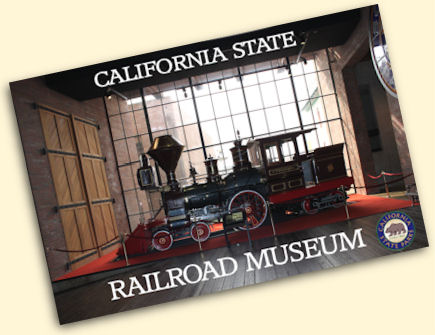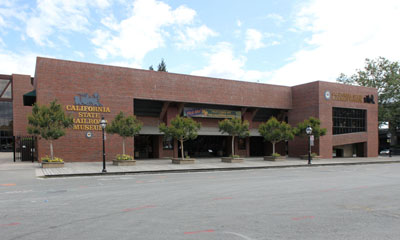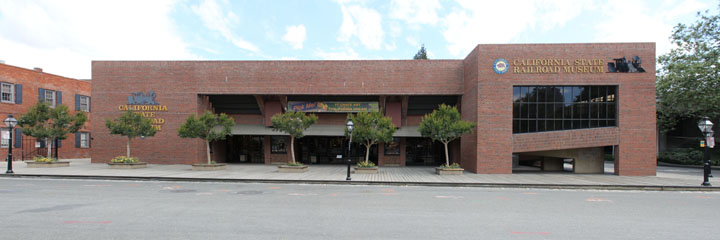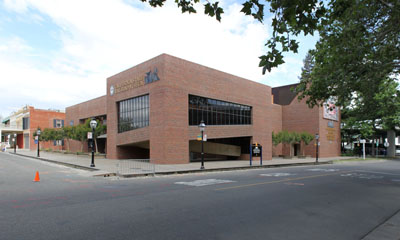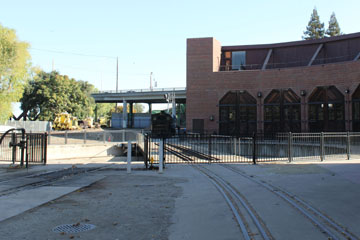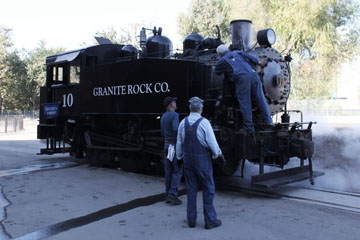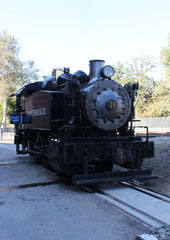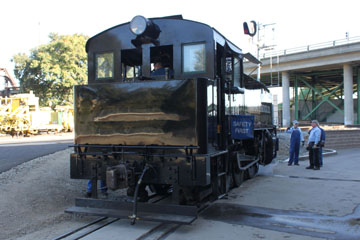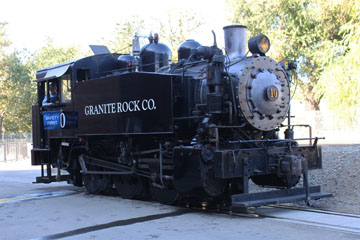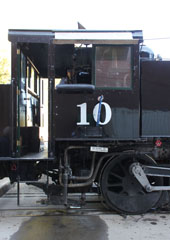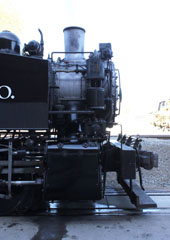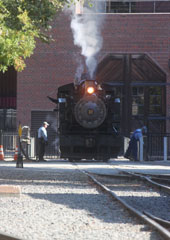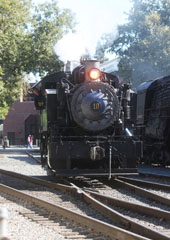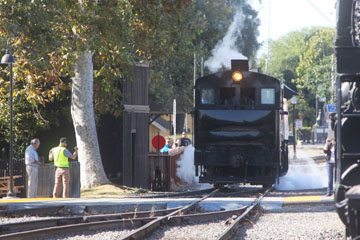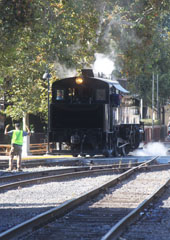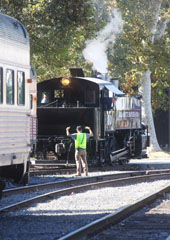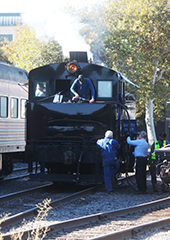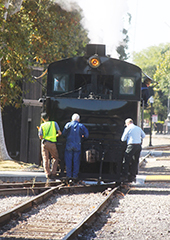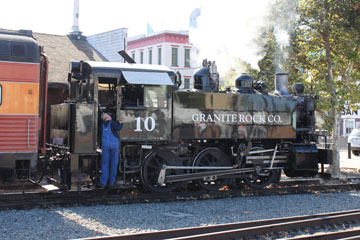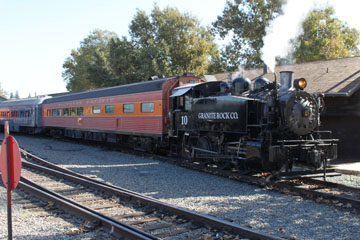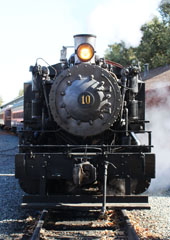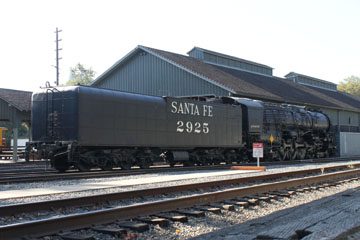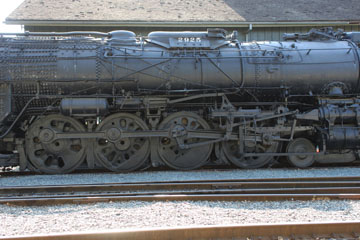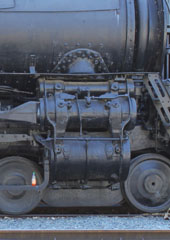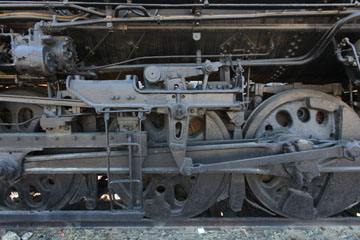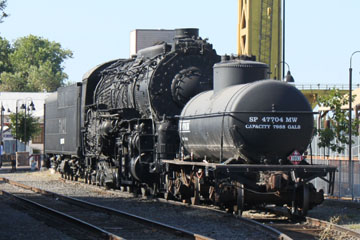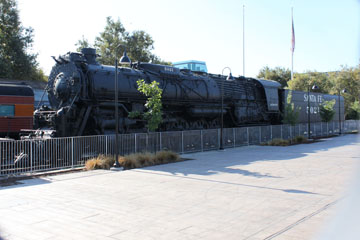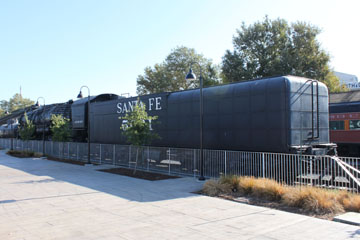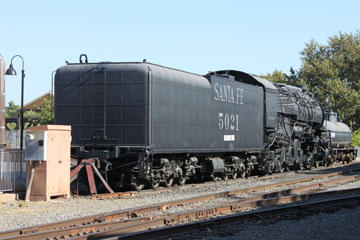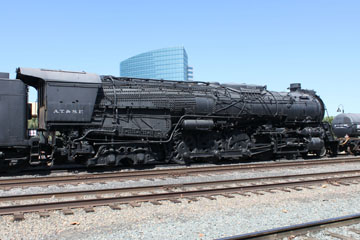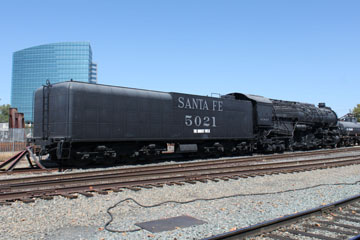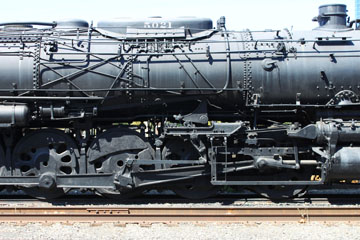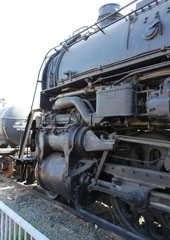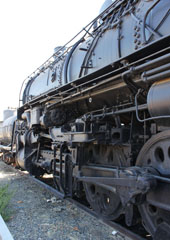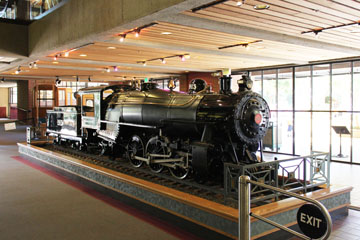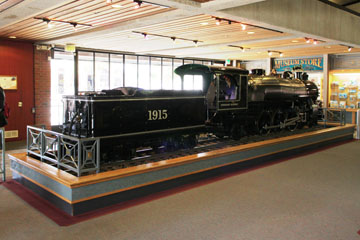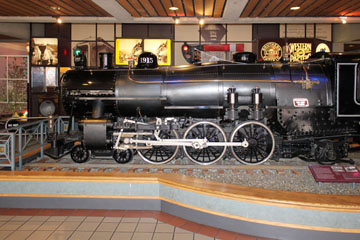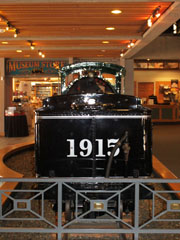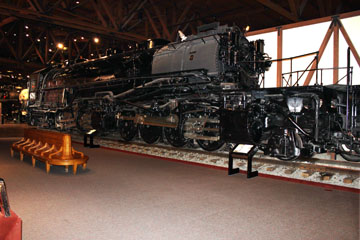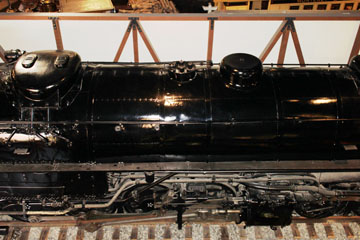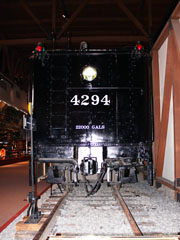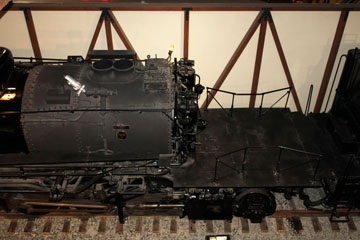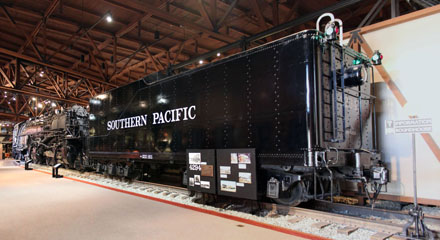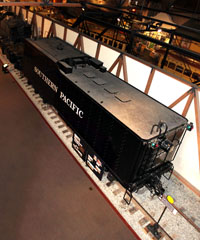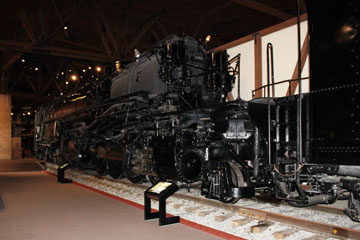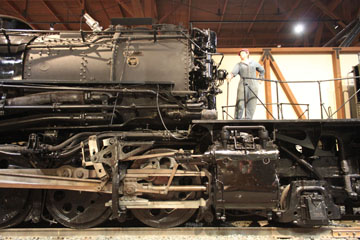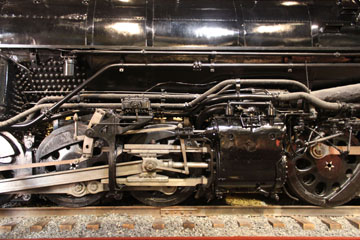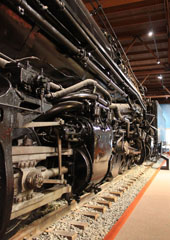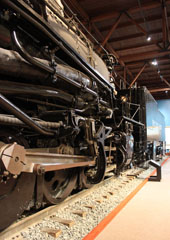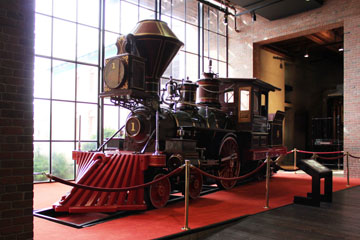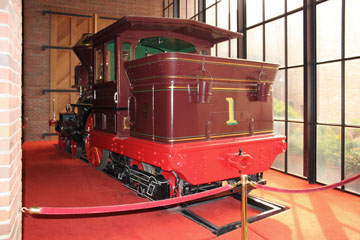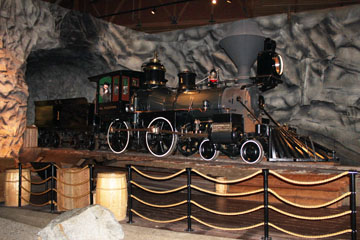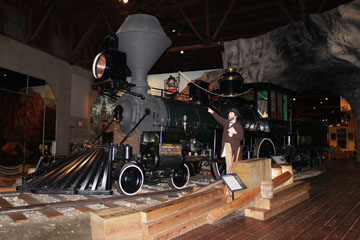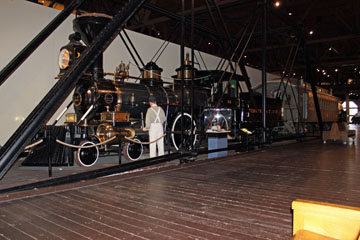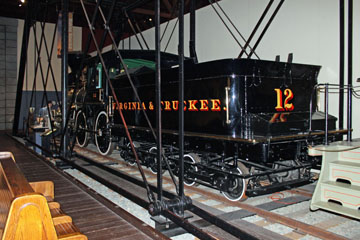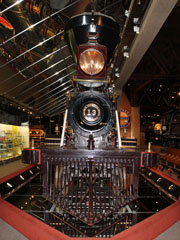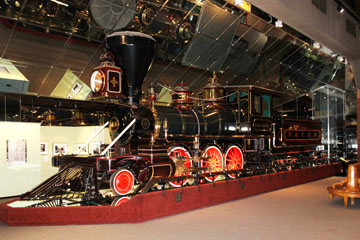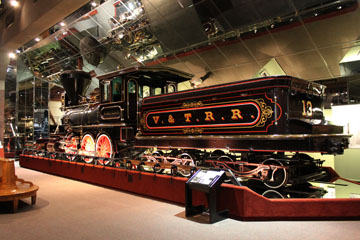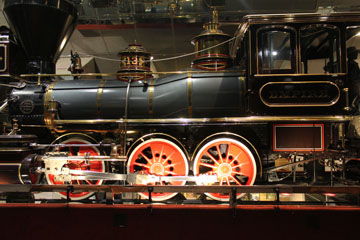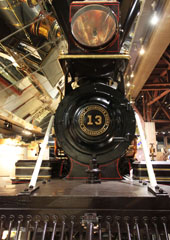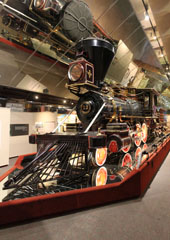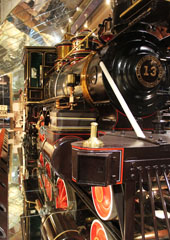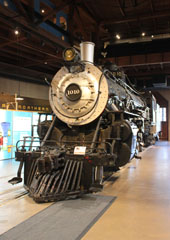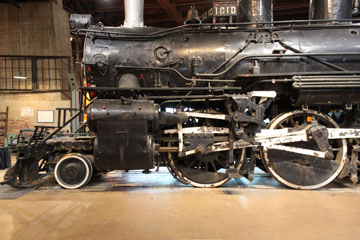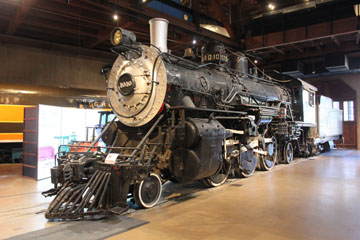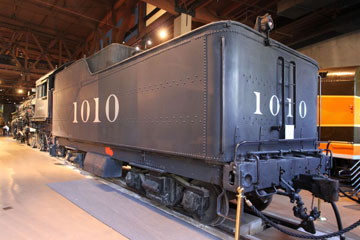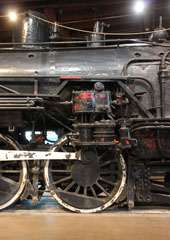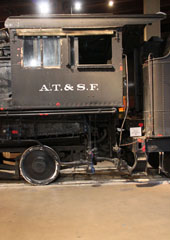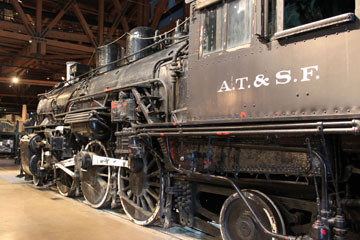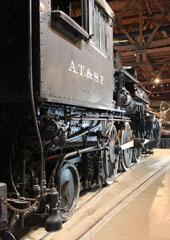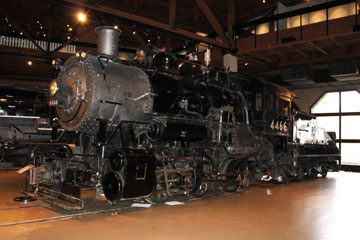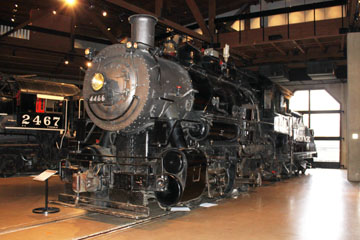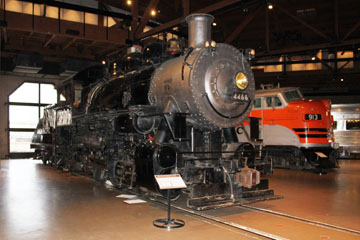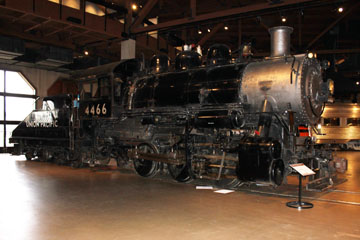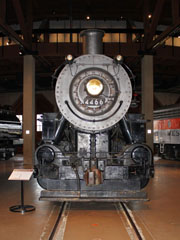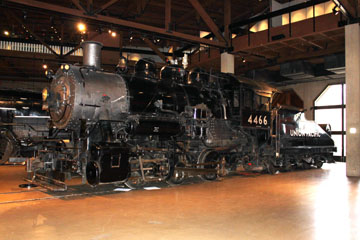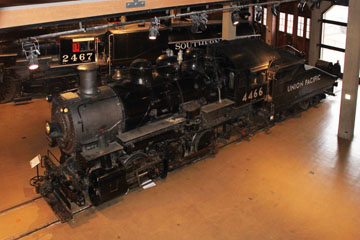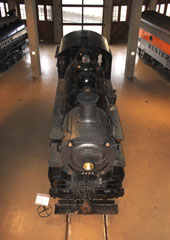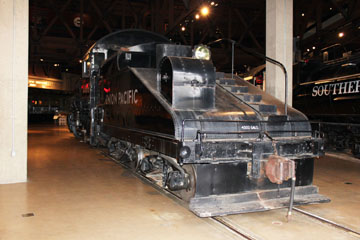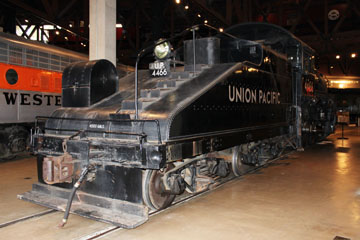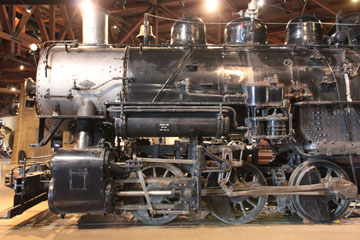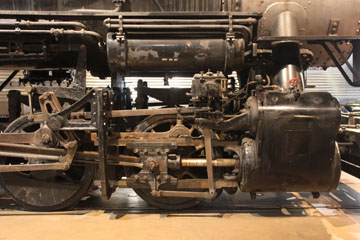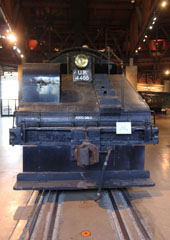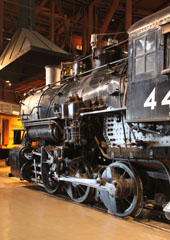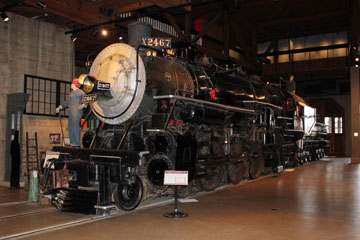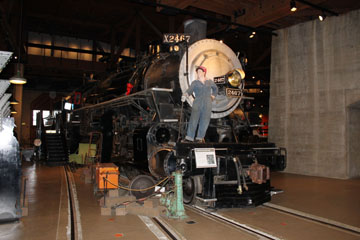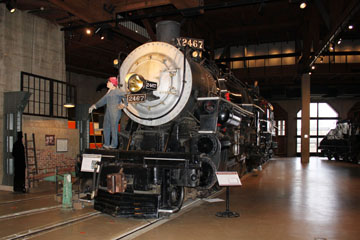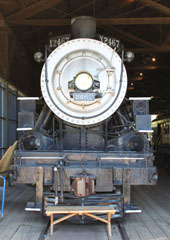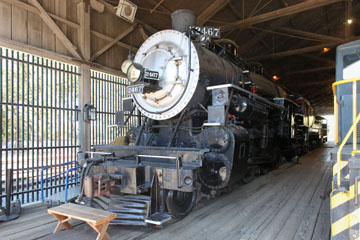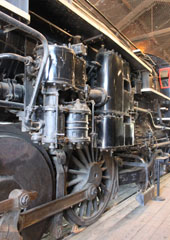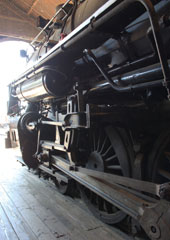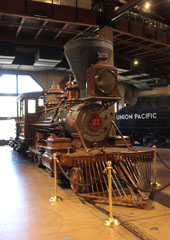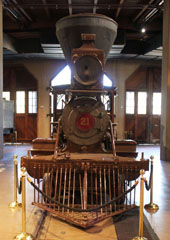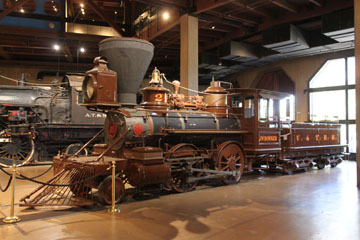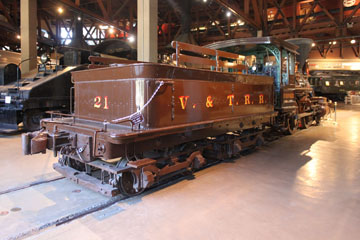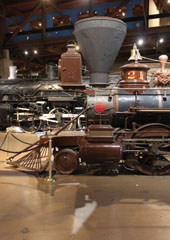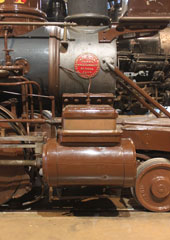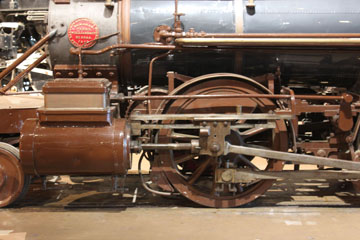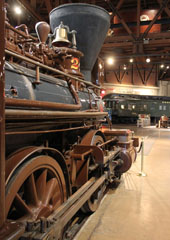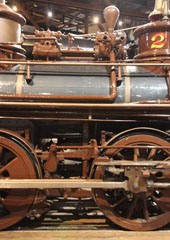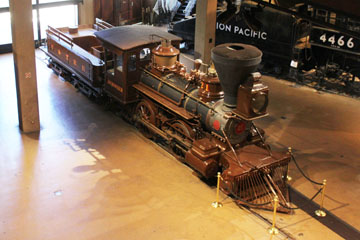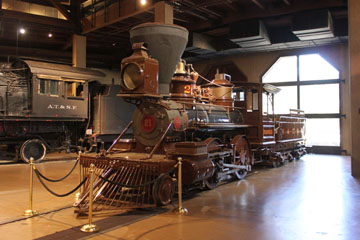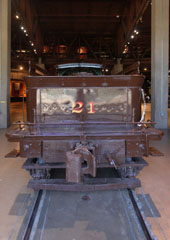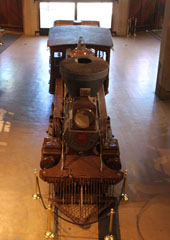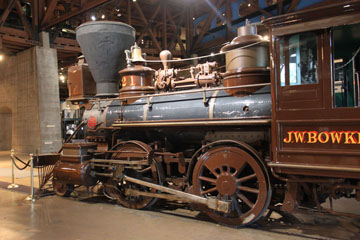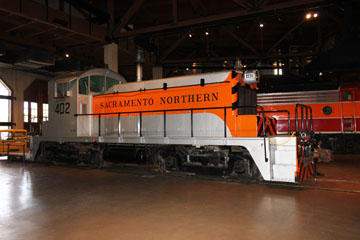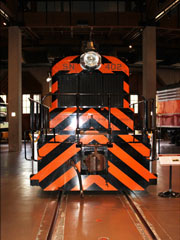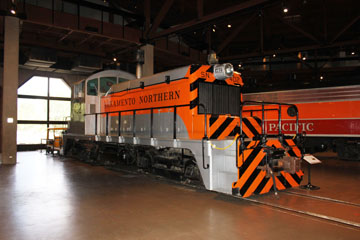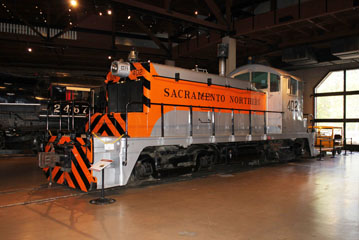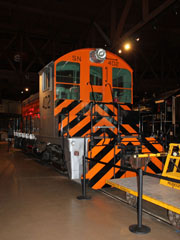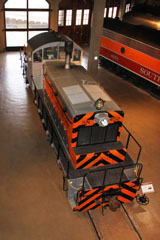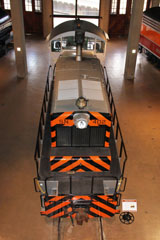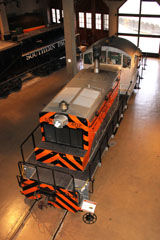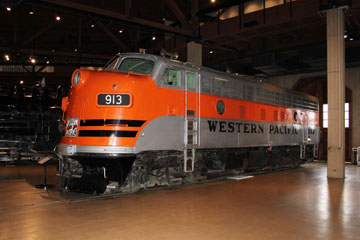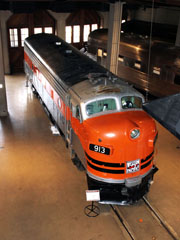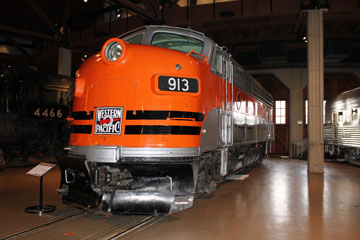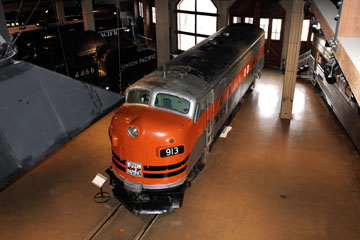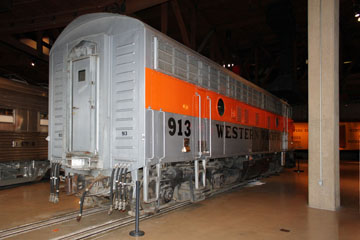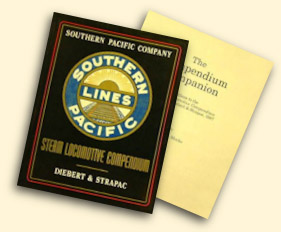The California State Railroad Museum, part of the California State Parks system, is located at 111 I St in Sacramento.
The museum had its origins in 1937, when a group of railroad enthusiasts in the San Francisco Bay Area formed the Pacific Coast Chapter of the Railway & Locomotive Historical Society. They acquired equipment and promoted the idea of a railroad museum, eventually donating thirty historic locomotives, wagons and coaches to the California Department of Parks and Recreation to form the nucleus of the collection.
The museum has a relatively small collection, but one of considerable historic significance in terms of western US railroads, particularly the Central Pacific and Southern Pacific. It also operates steam excursions in summer using its own motive power and, occasionally, that from other museums and historic collections.
I have visited the museum several times over the past years, so the equipment shown on this page reflects the content of different displays at different times.

Like an increasing number of institutions, except for specially organised events, the CSRM does not allow camera tripods to
be used in the museum. Leave yours in your car or expect to check it behind the ticket desk.
Unfortunately, because the displays are mostly indoors, with relatively low
lighting, getting good photographs without a tripod can be somewhat difficult, as many of the photographs on this page demonstrate!
The museum’s first facility in Sacramento, the Central Pacific Railroad Depot opened in 1976. The main museum building followed in 1981.
I find it to be incongruously modern, given its setting in the Old Sacramento State Historic Park, the historic region of downtown Sacramento, CA. Since the 1960s, the area has been developed as a tourist attraction, with restoration of its predominantly 19th Century buildings, cobbled streets and historic waterfront.
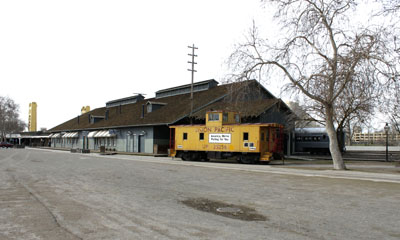

Above, the depot on Front St. It is designed in the style of an 1870s Southern Pacific Depot.
During the Summer season, visitors can explore the depot building, and steam excursions depart from here hourly 11am-5pm on Saturdays and Sundays. The forty minute trip goes about a mile south along the Sacramento River to Miller Park and back, using the museum’s tourist line, the Sacramento Southern Railroad. The Sacramento Southern owns the former Southern Pacific Walnut Grove Branch right of way that extends twenty-five miles south from Sacramento along the eastern bank of the Sacramento River.

Last time I visited the museum, Granite Rock #10 was being prepped for the day’s first excursion.
This 0-6-0 is one of 283 of the type designed by Col. Howard G. Hill and ordered by the United States Army Transportation Corps between 1942 and 1944 for switching duties in Europe and North Africa during World War II. They were built by the Davenport Locomotive Works (109), H. K. Porter (150) and the Vulcan Iron Works (123). Several continued to work on railrailroads in Europe as well as in Palestine, Iraq, Israel, Iran and China after the war.
The locomotive was built in 1942 by H. K. Porter as USAC #5001 and worked at the Tracy Defence Depot for five years until sold to the dealer Hyman-Michaels Co., in San Francisco, CA. That year, it was bought by the Granite Rock Co., and renumbered #10. It worked hauling rock from the company’s quarry near Watsonville, until replaced by a GE diesel switcher in 1951.
Granite Rock’s late President and CEO Bruce Woolpert restored the engine to full working order in the 1990s and donated it to the California State Railroad Museum in May 1997.
Above, #10 pulls off the turntable and into the
yard. The engine weighs 100,650 lbs. It has 54” drivers, Walschaert valve gear and 16½" x 24" cylinders. With an 18.3 sq ft grate, 86 sq ft
firebox and total heating surface of 876 sq ft,
it operates at a boiler pressure of 210 psi delivering 21,900 lbs tractive effort. The side tanks hold 1,200 gallons of water and the rear bunker 250 gallons of oil.
Below left, taking on oil. Below right, pulling forward to switch onto the line to connect with the day’s consist.

The 2900s were built with lightweight roller bearing rods, Walschaert valve gear and 80" Boxpok drivers, except for the fourth axle, which sported a 1938 style Baldwin Disc driver. Following WWII, between 1946 and 1948, all the 2900s were fitted with Timken roller bearing side rods with needle bearings on the valve gear.
The locomotives have an overall wheelbase (engine & tender) of 108' 2". The engine wheelbase is 50’ and the driver wheelbase is
21’ 3”. They weigh 510,150 lbs, 293,860 lbs on their 80" drivers.
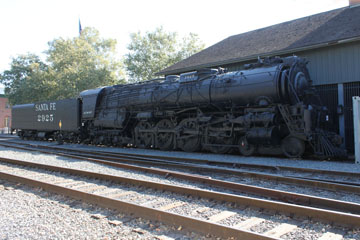
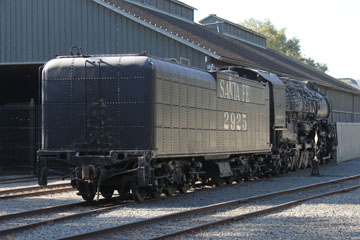
ATSF Class 2900 #2925 was parked in the yard.
It’s not possible to get close to the engine
without trespassing, so taking good photos is challenging.
This was one of a batch of thirty oil burning Northern type (4-8-4) locomotives delivered to the AT&SF in 1944 (#2900-#2929). The design was based on the their 3765 Class built in 1938, although wartime restrictions meant certain steel alloys were unavailable. As a result, alternative metals had to be used and these became the heaviest Northerns ever built in the US.
The engine has a 108 sq ft grate. Thermic syphons totalling 30.5 sq ft were fitted to the 479 sq ft firebox, with an additional 124 sq ft in an 84" long combustion chamber. With 2,366 sq ft superheating, #2921 had a total heating surface of 7,678 sq ft and, operating at a boiler pressure of 300 psi, it delivered 79,968 lbs tractive effort. It has an American multiple throttle and Worthington Type 6-SA feed water heater.
#2900's tender weighs 464,700 lbs loaded, with
a 245,000 gallon water and 7,170 gallon oil
capacity.

Features included Timken roller bearings fitted to all axles, including the tender trucks, Worthington 6SA feedwater heaters, cast-steel beds with integral cylinders and lightweight rods.
#5021 is 123' 5" long from rear tender coupler to front engine coupler, largely as a result of the enormous 42’ long 8+8 truck tender designed to hold 24,500 gallons of water and 7,000 gallons
of oil. The driver wheelbase is 26’ 2” and the engine wheelbase 50’ 2”. The engine weighs 536,000 lbs, 380,300 lbs on its 74" Boxpop
drivers.
Also parked in the yard was ATSF Class 5011 #5021, also difficult to photograph.
It is one of twenty-five oil burning Texas type (2-10-4) 5011 Class locomotives built for the AT&SF by the Baldwin Locomotive Works in 1944 (#5011-#5034). Designed to haul heavy freight at speeds approaching 70 mph, they were also used to meet the demands of increased passenger troop movements during the final years of WWII. The handsome 5011 Class arguably represented the peak of rigid-wheelbase freight locomotive design in the US.
The cylinders are 30” x 34”. With a 121.7 sq ft grate, 494 sq ft firebox fitted with 30 sq ft of thermic syphons and 2,640 sq ft superheating, #5030 had a total heating surface of 8,577 sq ft. Operating at a boiler pressure of 310 psi, it delivered 108,961 lbs tractive effort.
Despite a comparatively small firebox for their size, the 5011s were great steamers and much liked by crews for their smooth handling. Most were retired in 1950, but a few saw service as late as 1957. Finally, in 1959, all but the four set aside for preservation were scrapped.

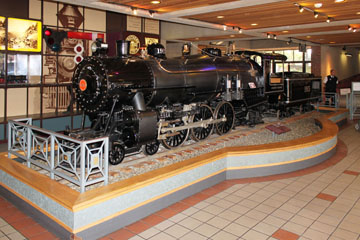
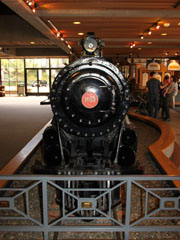
Overfair Railway #1915, a 19” gauge Pacific type
(4-6-2) locomotive is on display just inside the main entrance.
The Overfair Railway was the brainchild of Louis MacDermot and was built for the 1915 Panama-Pacific International Exposition in San Francisco, CA.
MacDermot built five locomotives based on the Alco designed Southern Pacific P-6 class, as well as sixty-two passenger cars and five freight cars.
The railway line ran five miles through the exposition grounds but its route away from the main centres of attraction and the 10c fare meant
it was not a great success. After the fair, MacDermot hung onto the equipment. After he died in 1948, it was progressively split up and passed through several different owners. #1915 was finally bought by Al Smith in 1983 and donated to the museum.
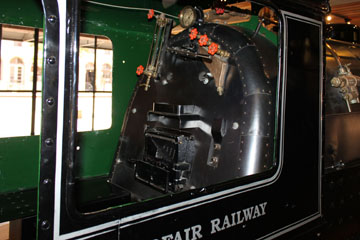
The engines were built as coal burners, 17’ long and weighing 12 tons empty. The firebox is 9 sq ft. The 12’ long wagontop boiler has one hundred and sixty-two 1” diameter tubes and is 30” in diameter at the smokebox. With 26” drivers and 9” x 10½” cylinders, they originally operated at a boiler pressure of 200 psi delivering 1,745 lbs tractive effort. The tender is 8’ long.
#1915 was never fired up. The three other survivors, #1912, #1913 and #1914, now owned and operated by Al Smith’s Swanton Pacific in Davenport, CA, have been converted to burn oil.
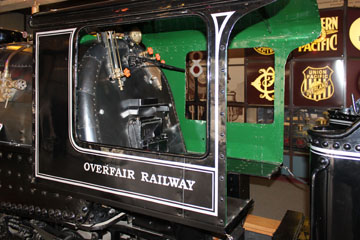
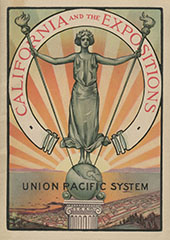
Above, the Union Pacific published a short guide to the 1915 Exposition (you can browse this guide from the books and manuals page of this website).
California and the Expositions makes no mention of the Overfair Railway, and only
twenty of its sixty
pages give any details on the Panama-Pacific Exposition in San Francisco and the
sister San Diego Panama-California Exposition. The remainder of the guide is devoted to touting the various benefits and comforts of choosing the railroad
to travel west from Ogden.

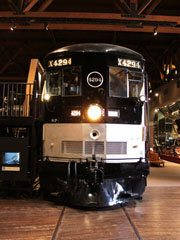
#4294 is the museum’s “signature engine”, the only surviving example of twenty Southern
Pacific articulated
4-8-8-2 cab-forward locomotives built by Baldwin in 1944 and the last steam locomotive delivered to the SP.
It was in service from March 1944 to March 1956, hauling both freight and passenger trains in Oregon as well as California, including the Overland Limited (Trains No.27 and No.28) over Donner Pass. It was donated to the City of Sacramento in 1958 and went on display at the Southern Pacific depot next to SP #1 “C. P. Huntington”.
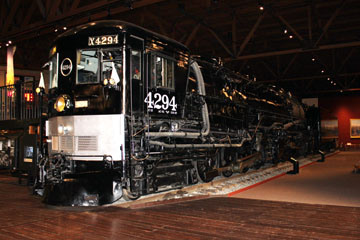
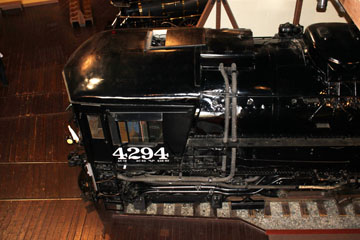
The cab-forward was developed by the SP to deal with its thirty-nine tunnels and nearly forty miles of snow sheds in the Sierra Nevadas, which could funnel exhaust fumes back into the cab of conventional locomotives. After a number of crews nearly asphyxiated, the SP experimented by running locomotives in reverse, but this meant the tender blocked the crew’s view and put them on the “wrong” sides of the cab to see signals.
So, the SP commissioned Baldwin to build a cab-forward, and the first fifteen 2-8-8-2s were delivered in 1910.
I do not find cab-forwards particularly attractive. Front on, they resemble diesels, and the extended “monkey deck” between the smokebox and tender just looks out of place to me.
#4294 is 127’ long and weighs 424,200 lbs, 356,900 lbs on its 63” drivers. Each driver wheelbase is 11’ and the total engine wheelbase is 54’ 10”. It has two sets of 24” x 32” cylinders. With a 70 sq ft grate, 344 sq ft firebox and total heating surface of 5,389 sq ft, including 1,022 sq ft superheating, it operated at a boiler pressure of 215 psi delivering 78,623 lbs tractive effort.
#4294’s tender weighs 320,000 lbs light and has a capacity of 22,000 gallons of water and 6,190 gallons of oil.
The oil bunker on the tender was made air-tight and was slightly pressurised at 5 psi from the main air reservoir. This was to insure a constant flow of oil to the burner in the firebox when the locomotive was travelling up a grade.
Above, note the “stack splitter” above the dual smoke stacks. This was to reduce the force of the exhaust, which otherwise could blow the roof boards off snow sheds. The constricted right of way in tunnels also occasioned the placing of the air pumps on the front of the smokebox.
The last batch of cab-forwards had a relatively short service life. The last revenue service was hauled by AC-10 #4211 from Oakland to Davis and Roseville on 30th November 1956, and
AC-11 #4274 made the last cab forward run over Donner Pass in November 1957.
Baldwin built two hundred and fifty-six cab-forwards for the Southern Pacific between 1910 and 1944, and their singular look soon became a symbol of the company.
Cab-forwards were also rostered in Italy and Prussia, and although some, like the Western Pacific, did consider them, no other US railroad ordered them.

The “C. P. Huntington” is the only surviving example of a 4-2-4 locomotive in the US, the
oldest locomotive owned by the museum and features on the museum’s logo. It weighs 43,500 lbs, has 54” drivers and 11” x 15” cylinders. A
coal burner, it operated at a boiler pressure of
110 psi and delivered 3,570 lbs tractive effort.
After transferring to the Southern Pacific, #1 operated as a light construction engine between San Jose and Hollister, CA, then in Oakland,
before ending its career as a weed burner, clearing track.
Also on display is the Southern Pacific’s first locomotive, named for the company’s then vice-president. Originally bought by the Central Pacific in 1863 as #3 from Danforth, Cooke & Co., in Patterson, NJ, it was also shipped around Cape Horn arriving in San Francisco on 19th March aboard the Mary Robinson.
Like CP #1, #3 was used to help build the transcontinental railroad as well as haul passenger trains. In 1871, it was transferred to the newly organised Southern Pacific Railroad and renumbered #1.

However, from 1894, #3 increasingly became a symbol of the Southern Pacific, appearing at station openings and exhibitions, including the 1915 San Francisco Panama-Pacific Exposition, the 1934 Chicago World's Fair and the 1969 Sacramento Gold Spike Centennial Celebration.
Donated to the State of California in 1964, #3 went on display at the old state fairgrounds on Stockton Blvd, Sacramento. Then, in 1979, it moved to the museum’s Central Pacific Railroad Passenger Station in Old Sacramento. It has been restored to how it appeared for the 1915 Panama-Pacific International Exposition.

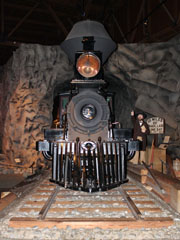
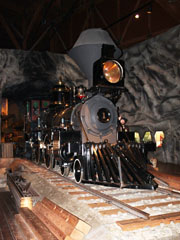
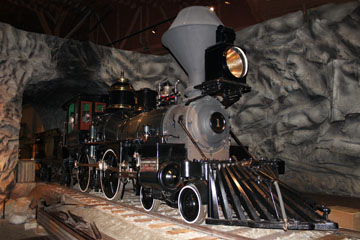
#1 “Gov. Stanford” is an American type (4-4-0) locomotive built in 1862 by Richard Norris & Sons of Philadelphia, PA, which was then one of the largest locomotive manufacturers in the US. It is the first engine ordered by the newly incorporated Central Pacific Railroad.
Disassembled and shipped in crates around Cape Horn on the Herald of the Morning, the locomotive arrived in Sacramento on 6th October 1863. Once reassembled, it was named in honour of the railroad’s then president, Leland Stanford, who was also Governor of California.
#1 hauled the CP’s first excursion train, first revenue freight on 25th March 1864 and first scheduled passenger train on 15th April 1864.
Downgraded from mainline service in 1873, #1 worked as a switcher and fire engine in the Sacramento area until retired in 1895.
It was then presented to Jane Lathrop Stanford, Leland’s widow, who donated it to the Leland Stanford Junior University. Soon after, #1 went on display in the university’s museum.
It remains the property of the university but is currently on loan to the museum.

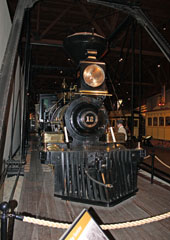
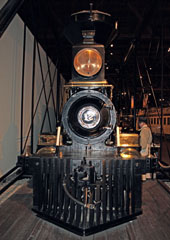
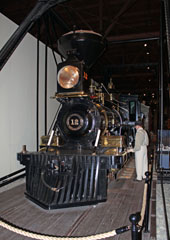
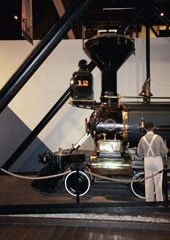
In 1938, #12 was sold to Eastern Railroads Conference and restored to look like Central Pacific’s #60 “Jupiter” for the 1939-40 New York World Fair, after which it was, presented to the Pacific Coast Chapter of the RLHS and shipped to the Western Pacific Roundhouse in Oakland, CA.
It also appeared at the 1948-49 Chicago Railroad Fair and, in 1969, appeared as “Jupiter” at the Golden Spike Centennial at Promontory, UT. That year, it was donated to the State of Nevada and loaned to the museum. In 1979, #12 was restored to its 1902 appearance.
#12 “Genoa” was built by Baldwin for the Virginia & Truckee in 1872 at a cost of $14,000. An American type (4-4-0), it is one of the oldest operable steam locomotives in the US. It weighs 65,000 lbs empty, has 16” x 24” cylinders and 56¾” drivers. Operating at a boiler pressure of 130 psi, it delivered 11,920 lbs tractive effort.
For twenty-eight years, #12 hauled mainly passenger trains, but also freight, between Carson City, Virginia City and Reno, NV, on the V&T. It was retired and went into storage in the Carson City shops in 1908.

In 1910, it was converted from a wood burner to an oil burner, and was renumbered #15, perhaps because engine crews thought #13 unlucky.
#13 was retired in 1918 and sold to the Pacific Portland Cement Company, in Gerlach, NV, in 1924. There, it operated as switcher #501 until retired again in 1931. In 1938, it was donated to the Pacific Coast Chapter of the RLHS and placed in storage in the San Francisco Bay Area. In 1976, #13 was moved to join the museum’s collection at the newly built Central Pacific Railroad Passenger Station in Sacramento.
VT #13 “Empire” was built by Baldwin for the Virginia & Truckee in 1873 for $15,250.
It is a Mogul (2-6-0) type locomotive weighing 70,000 lbs with 16” x 24” cylinders and 48” drivers. Operating at a boiler pressure of 130 psi, it delivered 14,600 lbs tractive effort.
In 1978, a total restoration based on period photographs and original drawings returned #13 to very much how it looked when it was delivered to the V&T in 1873.
The restored locomotive went on display in the new museum building when it opened in 1981.


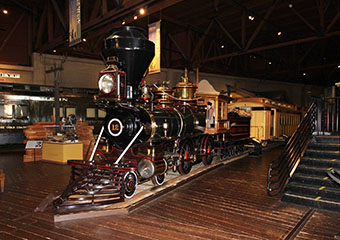
#12 was built by Baldwin in 1876 for the 36” gauge North Pacific Coast Railroad. Named “Sonoma”, it probably hauled both passenger and freight trains on the eighty mile line between Sausalito and Duncans Mills, CA.
In 1879, #12 was sold to the Nevada Central Railroad, renumbered #5 and named “General J. H. Ledlie” after the civil engineer then working for the railroad, who had also participated in building the transcontinental railroad as a Union Pacific employee. The following year, #5 was renamed “Jos. Collett”.
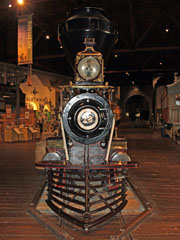
#5 worked as switcher and road engine until the Nevada Central line was abandoned in 1938. It was then acquired by Nevada Central’s General Manager, J. M. Hiskey, and was loaned to the 1939 Golden Gate International Exposition where it was restored to look like Central Pacific’s #60, the “Jupiter” for re-enactments of the Golden Spike Ceremony at Promontory, UT (there is a page on the Golden Spike NHS on this website).
After the Exposition, #12 was donated to the Oakland Chapter of the RLHS and went into storage in the San Francisco Bay Area
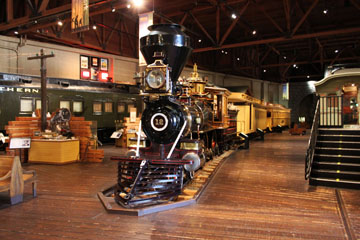
#12 stayed in storage for nearly forty years until it was moved to the newly built Central Pacific Railroad Passenger Station in 1977. The Hiskey family donated #12 to the museum in 1978. Restored to its 1876 appearance by the museum, it is displayed coupled to some narrow gauge passenger cars.
Built as a wood burning American type (4-4-0) locomotive, #12 was later converted to burn oil. It weighs 39,000 lbs and has 12” x 16” cylinders and 42” drivers. Operating at a boiler pressure of 135 psi, it delivered 6,100 lbs tractive effort.
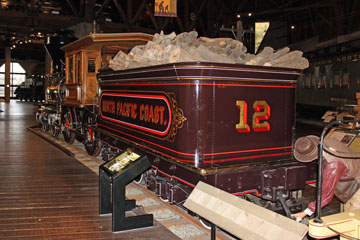

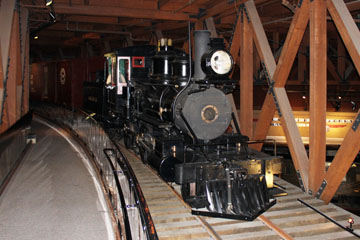
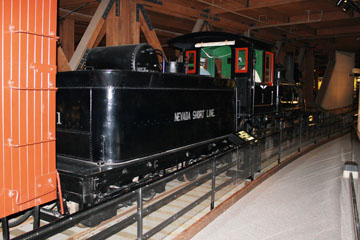
#1 is a narrow gauge (36”) oil burning Mogul type (2-6-0) locomotive built by Baldwin in 1879 for the Utah & Northern as #13. It weighs 39,000 lbs, 33,000 lbs on its 40” drivers, and has 12” x 18” cylinders. Operating at a boiler pressure of 135 psi, it delivered 4,900 lbs tractive effort.
#13 went through a number of different owners. It transferred to the Oregon Short Line & Utah Northern Railway as #17 in 1889. Ten years later, it was sold to the Glasgow & Western Exploration Co., and worked on the Golconda & Adelaide Railroad, where it was named “Pearl”.

In 1913, the Sugarman Iron & Metal Co., took over the Golconda & Adelaide and, the following year, sold #17 to the Nevada Shortline, which operated a 12½ mile line from Oreana to Rochester, NV.
In 1920, the locomotive was sold for scrap but was bought four years later by the Nevada Central and renumbered #6. Like North Pacific Coast #12, it was bought by J. M. Hiskey on that railroad’s demise and also steamed at the 1939-40 Golden Gate
International Exposition in San Francisco in the daily re-enactments of the 1869 Golden Spike ceremony.
After the Exposition, #1 was donated to the Oakland Chapter of the RLHS and went into storage in the San Francisco Bay Area. It was donated to the State of California in 1969.

As built the locomotives had 17" x 28" high pressure and 28" x 28" low pressure cylinders with Stephenson valve gear. They were simpled between 1922 and 1924 with 23.5" x 28" cylinders and fitted with Walschaert valve gear.
The locomotive is 70’ 6” in length with a 13’ 8½” engine wheelbase and 6’ 6” driver wheelbase. It weighs 209,220 lbs, 144,810 on its 79" drivers, with a 51.7 sq ft grate, 195 sq ft firebox and total heating surface of 3,179 sq ft. Operating at a boiler pressure of 220 psi, it delivered 27,991 lbs tractive effort.
#1010 is one of three Vauclain compound 2-6-2 Prairie type locomotives built by the Baldwin Locomotive Works for the AT&SF in 1901.
It was used on the "Scott Special", a planned 46 hour trip from Los Angeles to Chicago departing 9th July 1905. This was either the brainchild of Walter Edward Perry Scott, a publicity stunt by the Santa Fe, or both. The jury is out. #1010 hauled the train from Needles, CA, to Seligman, AZ, one of 19 steam engines on the 2,265 mile trip, which took 44 hours and 54 minutes, breaking all previous records.
Retired in 1955, #1010 was refurbished and used for a television
re-enactment of the “Scott Special” for the "Death Valley Days" program.
It also featured in a 1958 episode of the TV series Sky King, entitled "Stop That Train".

This 0-6-0 is one of thirty S-51 class switchers
built by Lima in 1920 for the Union Pacific. A coal burner weighing 159,000 lbs with 21” x 26” cylinders and 51” drivers, it operated at a boiler pressure of 180 psi, delivering 34,400 lbs tractive effort.
#4466 spent most of its working life in
Cheyenne, WY, as well as in Grand Island, NE. It was retired in 1962 and gifted to the museum by the Pacific Coast Chapter of the Railway & Locomotive Historical Society in 1978.
For many years thereafter, it hauled the museum’s weekend steam excursions.
The wooden running boards on the front pilot and rear of the tender provided a place for switchmen to stand as the locomotive moved about the yard. Below, as switching locomotives like #4466 frequently ran backwards as well as forwards, the tender is sloped to the rear (called “swallow tailed”) giving a better line of sight when
reversing.
You can see other Union Pacific 0-6-0 switchers on the UP S-4 #4420 page of this website, the Travel Town page and the Colorado Railroad Museum page.
#4466 is typical of thousands of 0-6-0 switchers that worked railroad yards in the US.
The 0-6-0 had dominated switching duties up to WWI, although heavier freight loads had brought more orders for 0-8-0s. Old road engines were also diverted to switching, either as-built or after their leading and trailing trucks were removed. After WWI, the success of the USRA 0-8-0 design led to a reduction in demand for 0-6-0s, although they continued to be outshopped into the 1940s: Lima’s last order was in 1943, when it supplied thirty-seven 0-6-0s to the US War Department.

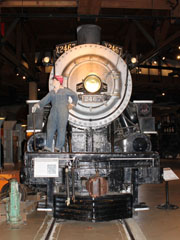
#2467 is one of fifteen heavy Pacific type
(4-6-2) locomotives built by Baldwin in 1921 for the Southern Pacific. They were designed for fast passenger service and could reach 100 mph, although they normally operated between 55 mph and 65 mph.
During the next decade, #2467 regularly hauled passenger trains on the Ogden, UT, to Sparks, NV, division, part of the railroad’s “Overland Route”. Then, over the next few years, it hauled local passenger services in the California area. It retired from service in 1956 and was donated to the City of Oakland in 1960.
#2467 was returned to service by the Pacific Locomotive Association for Railfair ‘99 held at the museum.
The engine’s flue time expired in 2005, so it will
need some work before it can return to steam.
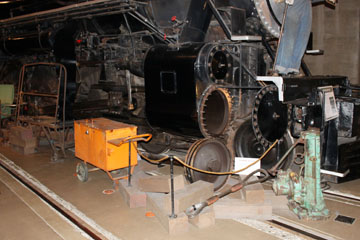
Above, the right hand cylinder has been opened up to give the suggestion the locomotive is undergoing repairs. The archly posed female mannequin on the front pilot is perhaps intended to add to the effect...
#2467 is an oil burner weighing 297,800 lbs, 180,000 lbs on its 73” drivers, it has 25” x 30” cylinders and Walschaert valve gear. With a 70.4 sq ft grate, 283 sq ft firebox and total heating surface of 4,190 sq ft, including 838 sq ft superheating, it operated at a boiler pressure of 210 psi, delivering 45,800 lbs tractive effort.

#21 is a 2-4-0 Porter type locomotive, built by the Baldwin Locomotive Works in 1875 at a cost of $8,000 for the Virginia & Truckee Railroad. It was named after V&T's master mechanic John William Bowker. However, in 1876, Bowker was fired for drunken, disorderly conduct and, four months after the engine was delivered, it was renamed "Mexico".
It worked as a switcher in Virginia City, NV, and around the Comstock Mines. In 1896, it was sold to the Sierra Nevada Wood and Lumber Company in Truckee, California, and renumbered #3.
In 1917, the locomotive was retired and stored in the Hobart Mills, CA, engine house for twenty years. It was then donated to the Railway & Locomotive Historical Society who restored it to its original identity as V&T #21. Cecil B. DeMille used the engine in his 1939 motion picture Union Pacific. Between 1939 and 1940, it was present at the New York World's Fair (you can see it on the New York World's Fair page of this website).
It last operated in 1953, when it was retired and was presented to the California State Railroad Museum some time later.
A wood burner, #21 has a a 13’ 8½” engine wheelbase and 6’ 6” driver wheelbase. It weighs 65,000 lbs, 48,.000 lbs on its 48¼" drivers, and is equipped with Stephenson valve gear and 14" x 22" cylinders. Operating at a boiler pressure of 130 psi, it delivered 9,875 lbs tractive effort. The 8 wheel tender held 12,000 gallons of water.
Left, the pumps at the top of the boiler, between the steam dome and sand dome, is a first class 6" Hooker steam fire pump (the original was a Knowles No. 6). Powered by the boiler, it was used to feed hoses to fight track-side fires.

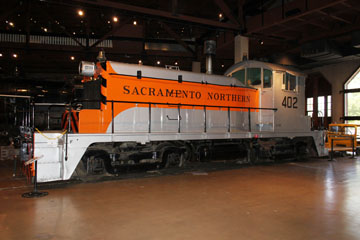

Six hundred and sixty-one of these 600 hp switchers were built by EMD between 1938 and 1953, all but one for US railroads. Pre-1945 units were powered by an EMD 567 prime mover. Post-1945 models had an improved 567A prime mover. They weigh 201,500 lbs and delivered tractive effort of 34,000 lbs at 11 mph.
Eleven SW1s have been preserved. You can see CG #1 on the Savannah Roundhouse Museum page of this website, Pere Marquette #11 on the B&O Museum Yard page and CWEX #15 on the Illinois Railway Museum Yard page.


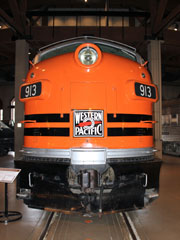
Two thousand, three hundred and sixty-six of these F7 A units, as well as one thousand four hundred and eighty-
three cabless B units were built between 1949 and 1953.
Fourth in EMD’s line of
F-units, the F7 was the highest-selling cab unit of all time.
#913 is an F7A unit built by EMD in 1950. It joined the Western Pacific roster as #920A, was renumbered #913A:2 in 1971 and then #913 in 1975. For thirty-one years, the unit hauled freight and passenger trains between Oakland, CA, and Salt Lake City, UT.
Weighing 230,000 lbs and 50’ 8” long, #913 has an EMD 567B 16 cylinder prime mover powering a GM D12B generator to drive four GM D27C traction motors. Delivering starting tractive effort of 56,500 lbs at 25% and 40,000 lbs at 9.3 mph, it has a top speed of 65 mph.
The WP rostered twenty-five F7A units and twenty-six B units. Six A units have survived:
#913A - Donated to the California State Railroad Museum 1981.
#917A - Sold to the Mt. Newman Mining Company in Australia in 1967. Now at the Pilbara Railway Historical Society, Western Australia.
#917D - Moved to the Western Pacific Railroad Museum in 2004 as part of a locomotive swap.
#918A - Donated to the Pacific Locomotive Association 1981.
#921D - Donated to the Western Pacific Railroad Museum in 1984.
#923A - Sold to the Mt. Newman Mining Company in 1967. Now on display in Port Hedland, Western Australia.
You can see other F7s on the Illinois Railway Museum Yard, B&O Railroad Museum Yard & Car Shop, UP Cheyenne Roundhouse, Tennessee Valley Railroad and Museum of the American Railroad pages of this website. Several F7s were also rebuilt by Morrison-Knudsen as F9PHs and used in passenger operations. Others were rebuilt as the FP10s and used by the Massachusetts Bay Transportation Authority.
A further eighty F7 A units and forty-seven B units were built by Alco subsidiary, the Montreal Locomotive Works, for service in Canada.
Many F7s were in service for decades, rostered on US railroads from Alaska to Maine, Minnesota to Texas, as well as in Mexico. They hauled some of the most famous trains in the US such as AT&SF's El Capitan and Super Chief, GN's Empire Builder and NP's North Coast Limited. As a result, the design has forged a place in popular imagination as the epitome of streamlined diesel-electric motive power.
